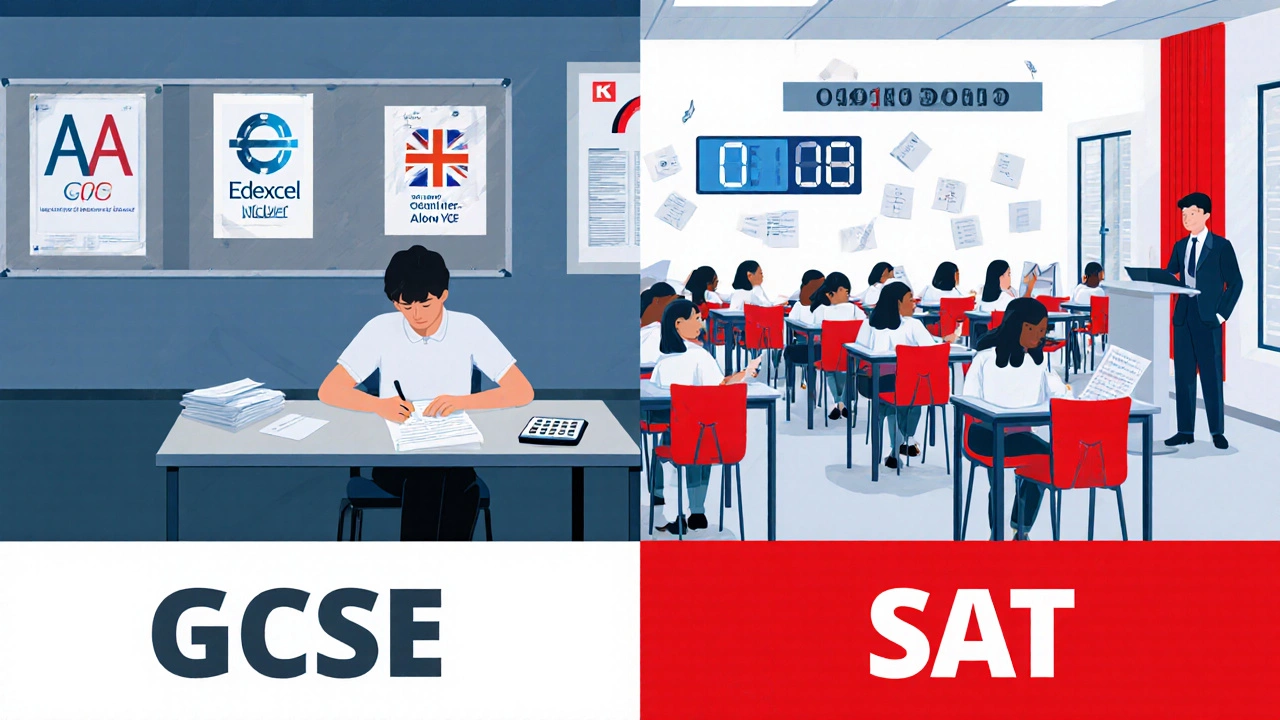GCSE to SAT Score Estimator
Estimate potential SAT scores based on your GCSE grades. This tool provides an approximate conversion to help with educational planning. Note: GCSE and SAT measure different skills, so these are general estimates only.
Estimated SAT Score
Key Context
- GCSE measures subject-specific knowledge taught in UK schools.
- SAT measures college-readiness skills in reading, writing, and math.
- Top US universities typically look for SAT scores of 1300-1500.
- A Grade 9 GCSE is roughly equivalent to an A* in the old system.
When comparing the UK's GCSE (General Certificate of Secondary Education) with the US SAT (Scholastic Assessment Test), students often wonder if they're alike. The short answer: they serve similar goals-measuring academic readiness-but the format, purpose, and scoring are worlds apart. Below we break it down step by step so you can see exactly where the two line up and where they diverge.
Quick Takeaways
- GCSE is a school‑based qualification taken at age 15‑16 in the UK; SAT is a college‑entrance test taken by high‑school juniors and seniors in the US.
- GCSE grades run from 9 to 1 (or U for ungraded); SAT scores range from 400 to 1600.
- GCSE results affect A‑Level or vocational pathways; SAT results influence university admissions and scholarship offers.
- GCSE is subject‑specific (Math, English, Science, etc.); SAT has two mandatory sections-Evidence‑Based Reading & Writing and Math-plus an optional Essay.
- Preparation resources differ: UK exam boards publish past papers; US students rely on College Board practice tests and commercial prep companies.
What Exactly Is the GCSE?
The GCSE is the main qualification taken by students in England, Wales and Northern Ireland at the end of Key Stage 4. It replaced the old O‑Level/GCSE hybrid in 2015 and is overseen by Ofqual, the regulator that sets standards for exam boards like AQA, Edexcel, OCR, and WJEC. Each subject is examined separately, usually with a written paper (or multiple papers) and occasionally coursework.
Key attributes:
- Age group: 15‑16 (Year 11)
- Number of subjects: Typically 5‑10, depending on school policy
- Grading scale: 9 (highest) to 1 (lowest); U means ungraded
- Duration: Most papers last 1‑2 hours; some practicals last longer
Because GCSEs are school‑based, teachers decide how much class time to allocate for each subject, and the exams are scheduled by the exam board in May/June (and sometimes November for resits).
What Exactly Is the SAT?
The SAT is a standardized test created by the College Board. It’s taken by high‑school juniors and seniors across the United States and increasingly by international students aiming for US universities. Unlike GCSEs, the SAT isn’t tied to a national curriculum; it measures college‑ready skills in reading, writing, and math.
Key attributes:
- Age group: 16‑18 (high‑school juniors/seniors)
- Sections: Evidence‑Based Reading & Writing (EBRW) and Math; optional Essay (discontinued after June 2021 for most schools)
- Scoring: Each section 200‑800; total 400‑1600
- Frequency: Offered seven times a year (October, November, December, March, May, June, August)
The test is administered at designated centers, and students must register online months in advance.
Purpose Comparison: Why Do Students Take Each Exam?
Both exams act as gateways, but they open completely different doors.
- GCSE: Determines eligibility for A‑Levels, vocational routes (BTECs, City & Guilds), and sometimes employment. Universities in the UK look at A‑Levels, but strong GCSE performance can be a fallback qualifier.
- SAT: Directly used by US colleges in admissions decisions, scholarship eligibility, and sometimes placement into remedial or advanced courses. Some British universities also ask for SAT scores if you apply as an international student.
So while the underlying goal-showing academic capability-is shared, the downstream impact is specific to each education system.

Structure & Timing: How the Tests Are Built
Understanding the format helps you plan study time efficiently.
| Aspect | GCSE | SAT |
|---|---|---|
| Administered by | Exam boards (AQA, Edexcel, etc.) | College Board |
| Number of papers per subject | 1-3 (depends on subject) | 2 mandatory sections + optional essay |
| Total test time | Varies; usually 1-2 h per paper | 3 h (no‑penalty multiple choice) |
| Scoring method | Grades 9‑1 (numeric) or letters (A*‑G) | 400‑1600 (numeric) with sub‑scores |
| Use of calculators | Only in specific math papers | Allowed on whole Math section (no‑calc & calc parts) |
| Retake policy | Resits in November/January | Can retake any administration date |
Notice the SAT’s uniform timing versus the GCSE’s subject‑by‑subject spread. That’s why SAT prep often focuses on stamina and test‑taking strategy, while GCSE revision leans heavily on content knowledge per subject.
Grading & Results: What Do the Numbers Mean?
Both systems translate raw performance into a final mark, but the interpretation differs.
- GCSE grading: Marks are converted to grades using a grade boundary set by the exam board each year. A grade 9 roughly equals an A* in the old system; grade 4 is considered a ‘standard pass’.
- SAT scoring: Each correct answer earns a raw point; raw scores are then scaled to the 200‑800 range per section. A total of 1200-1300 is often seen as competitive for top US universities.
Because SAT scores are numeric, colleges can set precise cut‑offs (e.g., “minimum 1400 for engineering”). GCSE grades are categorical, limiting precise statistical comparison across schools.
Study Resources: How to Prepare Effectively
Preparation approaches differ, reflecting each exam’s nature.
GCSE Resources
- Past papers from your exam board (available on the board’s website).
- Spec‑focused revision guides (e.g., CGP, Pearson).
- Teacher‑led revision sessions and coursework feedback.
- Online platforms like BBC Bitesize or Seneca Learning.
SAT Resources
- Official College Board practice tests (free PDFs & digital).
- Commercial prep books (The Official SAT Study Guide, Kaplan, Princeton Review).
- Online courses (Khan Academy’s free partnership with College Board).
- Private tutoring firms (e.g., PrepScholar, Magoosh).
Both exams benefit from timed practice, but the SAT demands more focus on pacing and answer‑elimination techniques, while GCSEs reward deep content mastery and exam‑specific tricks like “show your working”.

Common Misconceptions
Let’s clear up a few myths you might have heard.
- Myth: Scoring a 9 in GCSE is the same as a 1600 on the SAT.
Fact: They measure different skills. A 9 shows mastery of a UK curriculum; a 1600 reflects high proficiency in US college‑readiness standards. - Myth: You can retake the SAT anytime, just like GCSEs.
Fact: SAT dates are fixed; you must register in advance and can only retake on scheduled test days. - Myth: All UK schools follow the same GCSE syllabus.
Fact: Each exam board can have slightly different specifications, especially in subjects like History or Science.
Which Exam Is Right for You?
In most cases you’ll need to take both-GCSE for your UK schooling and SAT if you aim for US universities. However, if you’re weighing study time, ask yourself these questions:
- Are you applying to a US college that weighs SAT scores heavily? If yes, allocate dedicated SAT prep weeks.
- Do you need a strong GCSE record to secure a place in A‑Levels or a vocational program? Then prioritize subjects where you’re weakest.
- Do you have access to resources? UK schools provide past papers for free; SAT prep often requires paid tools if you want structured courses.
Balancing both is doable: schedule GCSE revision during term time, then use school holidays for intensive SAT practice.
Final Checklist Before You Finish Your Prep
- Confirm exam dates and registration deadlines for both GCSE and SAT.
- Gather official past papers and practice tests.
- Set a weekly timetable: 2‑3 days for GCSE subjects, 1‑2 days for SAT sections.
- Take at least one full‑length timed practice for each exam.
- Review your results, note weak areas, and adjust your study plan accordingly.
Cross‑checking your timeline against school holidays and SAT test windows can prevent last‑minute rushes.
Do GCSE results affect US college admissions?
US colleges mainly look at SAT/ACT scores, GPA, and personal essays. Strong GCSE grades can bolster a transcript, especially for international applicants, but they’re not a primary factor.
Can I take the SAT before finishing my GCSEs?
Yes. Many students sit the SAT in Year 10 or early Year 11 to give themselves extra time to improve scores before university applications.
How many times can I retake the GCSE?
You can sit the same GCSE up to three times: the original May/June session, a November or January resit, and a second resit if needed, subject to school policy.
Is the SAT harder than the GCSE?
Hardness is subjective. The SAT tests critical‑thinking and speed on a standardized test, while GCSEs test detailed subject knowledge taught in school. Your strengths will dictate which feels tougher.
What resources are free for SAT prep?
The College Board offers two free practice tests and a partnership with Khan Academy provides personalized practice exercises at no cost.
